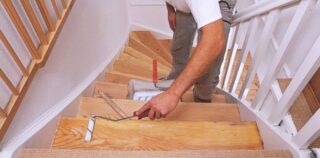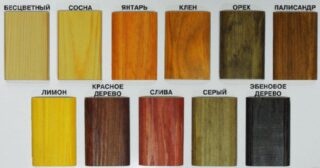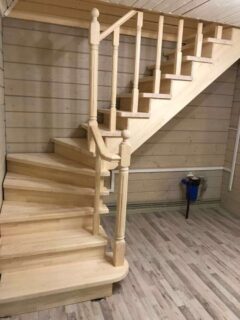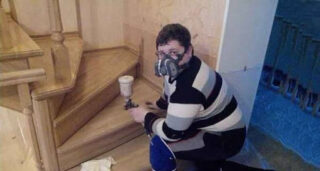A staircase is a must-have element in a two-story house, which allows you to move between different levels. It is made from different materials, the most popular is wood. Such structures are environmentally friendly, durable, but require protection. Painting the stairs ensures its durability, decorative appeal, and also increases resistance to mechanical damage.
The need to paint a wooden staircase

Natural wood is a strong material, but it is subject to the negative effects of moisture and insects. Intense mechanical stress leads to a decrease in its technical characteristics and visual appeal. An unprotected surface wears off faster and absorbs dirt.
To preserve the original appearance of the stairs, to extend its service life, paint is used. It not only helps to arrange the structure in accordance with the style of the interior and protects the surface from destruction under the influence of direct sunlight and moisture. It is easier to remove dust and dirt from the treated surface. Some compounds increase the resistance of wood to mechanical stress.
Requirements for dyes
Paint for a wooden staircase inside the house must be safe, not contain toxic substances, and not emit an unpleasant odor. When choosing a finish, the following factors are taken into account:
- Wood species. Coniferous structures are characterized by low adhesion to paint, as they emit resin. The absorption of the finishing composition is uneven, therefore, paint with good hiding power is required.
- Construction color. If you need to preserve the texture, it is better to choose a transparent or tinted varnish. If there are small defects on the surface of the steps, paint will do.
- Resistant to direct sunlight. If the staircase is on the south side of the room, a fade resistant compound should be used.
- Wear resistant paints are required when the stairs are heavily loaded.
More practical are matte or semi-matt finishes. The glossy surface wears off quickly.
Varieties of compositions for painting

You can paint wooden stairs with enamel or paint. Impregnations and varnishes are also used as a topcoat.
Lucky
The varnish creates a transparent film on the surface of the wood that enhances the texture. These products often contain pigments that tint the structure. The following types of varnishes are used for the stairs:
- Transparent, acrylic-based. They do not contain toxic components, but are not resistant to mechanical stress. Not recommended for decorating structures with high traffic. The substance contains an acrylic dispersion, an antiseptic, and a plasticizer.
- Transparent alkyd. The coating is resistant to moisture, so it can be applied to structures in rooms with high humidity or outdoors. It is allowed to wash steps covered with such varnish by any means. It dries long enough.
- Oil toning. Change the shade of the stairs. For wood, they can be used if the composition contains at least 65% oils. Varnishes with a lower percentage are used only for roughing the steps.
The best option is a polyurethane mixture. It is resistant to temperature extremes, moisture, abrasion, therefore it is good for outdoor use. However, this coating turns yellow over time.
Paints

To paint the stairs to the second floor inside the house, you need compositions designed specifically for internal application. You can use the following coatings:
- Acrylic. These are quick-drying paints that do not have a pungent odor. They do not impair air exchange, they provide decorative design for a long time.
- Alkyd. They contain pigment and antiseptic, so they protect the surface well from moisture, prevent the spread of mold and mildew. They create a matte or glossy surface and are characterized by a wide range of colors.
- Oil. Their advantage is a wide color palette, low consumption. They fit well on a carefully prepared surface. However, the coating contributes to the disruption of air exchange, is quickly erased, fading in the sun. During operation, the substance must be stirred periodically, since the coloring pigment gradually settles to the bottom. Until completely dry, the paint emits a pungent odor.
The choice of paint is carried out depending on the size of the structure, its load and architectural features. The paint is great for cheap wood species. Dear ones have a beautiful texture that should not be hidden.
Enamels
Enamel is a dense structure containing colorless varnish and pigment. A durable film is created on the surface of the wood, providing good decorative qualities. This finish protects the staircase from the influence of ultraviolet radiation, temperature extremes, and moisture.
Impregnations
Impregnation is a liquid containing pigment. It does not completely change the color of the wood, but only gives it a certain shade. The solution contains antiseptics that improve the resistance of the structure to the influence of moisture, as well as fire retardants that increase the fire protection of the steps. For stairs, oil or wax-based impregnations are more suitable. They are evenly distributed on the surface, easy to lay down. The product can be purchased ready-made or in the form of a powder that needs to be dissolved.
The subtleties of working with different paintwork materials

It is not difficult to paint wooden stairs made of larch or oak: they do not require special preparation. Conifers are more difficult to work with. They will have to be degummed. If the resin sticks to the surface, the paint will not be able to penetrate into the wood grain and firmly adhere. The decorative coating will peel off quickly.
If tar spots are left on the steps, they will gradually darken. The finishing material will not adhere evenly to such a surface. To eliminate the problem, the surface of the structure is treated with a solvent: acetone solution (25%). Before applying the product, wash the ladder with warm water and dry thoroughly. The resin fragments are removed with a knife. The paint is applied after the structure is completely dry. This takes 1-2 days.
Preparatory work
To prepare the stairs for painting, the following activities are carried out:
- remove the old paint layer with a remover and a spatula;
- grind the steps and railings with coarse sandpaper, and then with fine grain (you can use a grinder equipped with a grinding wheel No. 60-80, and then - No. 120-150);
- clean the structure of dust - you can use a damp cloth or vacuum cleaner;
- sealing chips and cracks with putty, and deep crevices are clogged with small chips and poured with PVA glue;
- final polishing of the surface with fine-grained emery paper.
Lastly, the ladder is primed. After a day, the structure is re-treated with a protective compound. If the steps will be varnished, it is not necessary to prime them.
Tools and materials
For the correct painting of a wooden structure, you will need the following tools and materials:
- sandpaper of varying grain size or grinder with grinding wheels;
- wide and narrow paint brushes or roller for applying primer and finishing material;
- spatula for filling cracks;
- building hair dryer to remove the old paint layer if necessary;
- clean rags;
- tray for paint.
If mixtures of different colors are used to paint the structure, masking tape is needed for accurate application. A universal filler is required to seal the cracks.
DIY painting a wooden staircase

You can paint a wooden staircase with your own hands. The following sequence of work is observed:
- Elimination of dust, dirt. Cleaning the structure from oil and other stains. It is necessary to dust the entire room. If even small fragments of debris get on the surface of the steps, they will be visible under the paint.
- Sealing small cracks with putty. It takes 1 day to dry. After that, all the treated areas are cleaned with sandpaper.
- Primer application. Stain is often used instead. You need to apply the composition in 1-2 layers. Moreover, each previous layer must dry out for at least a day.
- Application of finishing material. Stir the paint thoroughly to break up the lumps. For work, you can use a brush, roller or spray gun. No solid drops or smudges should remain on the surface.
To prevent the paint from cracking and exfoliating during drying, it is necessary to provide a moderate air humidity in the room. For additional protection of the decorated surface from abrasion, you can apply a top coat of varnish. Most types of materials have a strong chemical odor, so work in a well-ventilated area with a respirator.








